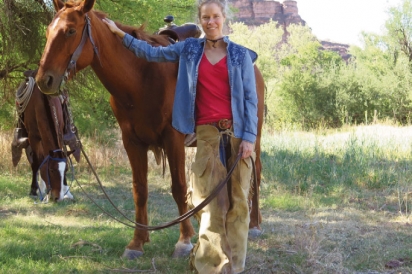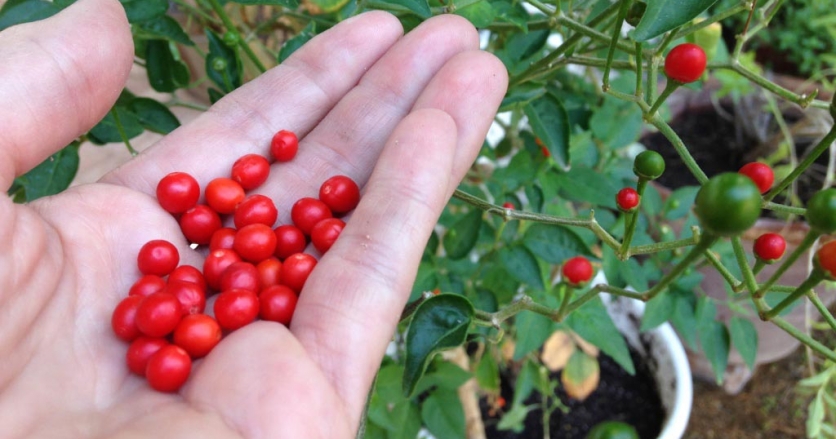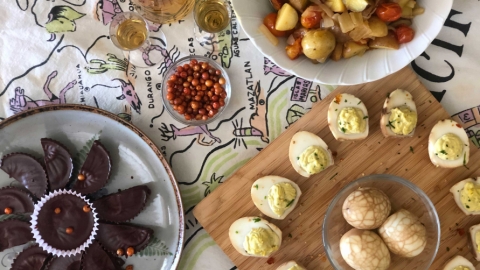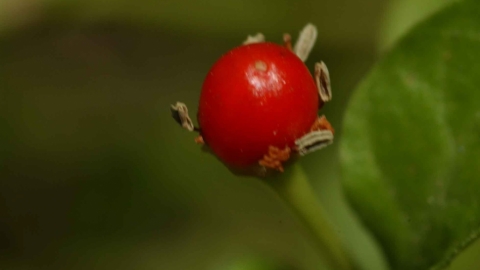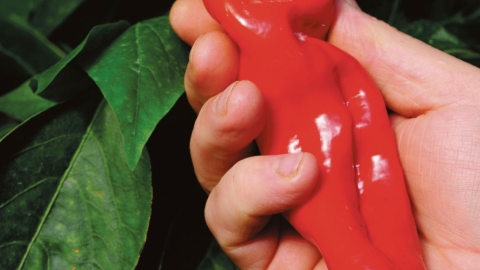Lessons from the Way of the Wild Chile
“It’s a great teacher for where we are on the planet right now,” Linda McKittrick says, referring to the wild chile (the chiltepin).
In 22 years of ranching, she’s come to intimately know the wild chile and learn from it. She is a Tucson artist, cook, gardener and philosopher. McKittrick also owns a cattle ranch in Sonora, where the chiltepin thrives in canyons and on steep mountainsides.
The chiltepin (Capsicum annuum var. glabriusculum), the progenitor chile, the mother of all modern chiles, grows in wild abundance in the Sonoran Desert of Southern Arizona and Northern Mexico, and the fiery-hot fruits are a staple in Sonoran cuisine. But for McKittrick, there’s more to the chile than just food.
For her, the “what” of the chile—its flavor, aroma, vitamin content, wild genetics—is important, but the “how” of the plant is equally compelling. “We, in our own lives and back yards, can use the ‘how’ of the wild plant ancestors to learn to live on the planet differently,” she says.
To her, the chiltepin’s “how” offers perennial wisdom: that of rootedness, resilience, collaborative partnerships and exchange, rather than exploitation and extraction. McKittrick, who has studied at Wes Jackson’s Land Institute, cites him as one of the influences on her evolving thinking about the nature of wild plants and our interactions with them.
The chiltepin’s deep roots allow the plant to survive even during drought or floods, and the plants growing on McKittrick’s ranch have bounced back after deep, hard freezes. Birds feast on the berries—their systems don’t metabolize capsaicin, the alkaloid that gives chiles their burn—and spread the seeds beneath their roosts in the mesquite trees and hackberry bushes that then become nurse plants to protect the chile seedlings. As the chiltepin bushes grow, the nurse plants function as scaffolding, supporting the chile plants as they soar to 10 feet or more. It’s a mutually beneficial and diverse perennial ecosystem.
Even while the chiltepin is prolific in parts of the Sonoran Desert, loss of habitat due to development, the changing climate and overharvesting are taking a toll.
The chile is listed on Slow Food’s Ark of Taste, a catalog of endangered and rare food products and traditions. “This plant, yeah, it’s in jeopardy because of climate change and it’s in jeopardy because humans overharvest it, and I’ve seen that, but it does thrive. It thrives. And not just survives,” says McKittrick. “So, humans could take a page out of nature’s book, so to speak. There’s a hardiness to chiltepins, and we can all be somebody’s scaffold. That’s part of the ‘how’ piece.”
The tiny red chiltepin berries measure between 100,000 and 300,000 Scoville units (very hot!), depending on the location of the plant and the amount of rainfall it received during the season. The heat is intense, but short-lived—it flares, but then recedes quickly, leaving behind a pleasant warmth on the back of the tongue. The flavor is fruity with citrus notes. When picked green, the fruits are pickled in vinegar with garlic and other native spices like wild oregano or turned into salsa. But most of the time, they ripen to red on the plant. Borderlands cooks sometimes use them fresh, but usually they’re dried for long-term keeping. Unlike its domesticated chile descendants, the chiltepin is a perennial, and some plants have been known to live in the wild for up to 50 years.
McKittrick has worked alongside the local chiltipineros (harvesters) for hours on end in the fall when the chiles start to ripen. “The thing I like about it is that it requires some effort, but it’s fun too,” she says. “You’re on rocky ledges, there are snakes, it’s hot, it’s cold, it’s windy. But when you go from plant to plant to plant, for several hours a day, day after day after day, you find some with tiny chiles and some with bigger ones; they mature at different times because of the different microclimates. It’s like getting to know nonhuman people.”
That diversity is one of the things McKittrick appreciates about the wild chiles. “Humans want to standardize everything, but I like things that are nonstandard,” she says. “If you love harvesting mesquite pods, you know which trees are sweetest, or which nopal you like, or which cholla buds.” The same is true of chiltepin. It’s the idea of place, similar to the concept of Daodi in Chinese medicine. “A rocky ledge chiltepin versus one down by the stream, versus one under the mesquite, versus one around the sotol—they’re all a little bit different,” she says.
The wild version also varies markedly from the domesticated version grown in some parts of Sonora. Says McKittrick, “What I’ve seen firsthand are unbelievable amounts of fertilizer, fungicides and pesticides. It’s not good for people, and the plants seem to be stubbier. The fruit’s not as hot and it looks slightly different. You wouldn’t know it when it’s packed up and sent to market. But people on the ground who know will say it doesn’t have the same flavor, it’s not as hot, and it doesn’t have the same aroma.” To McKittrick, it’s another sign of the exploitation of the chile and a mind-set that keeps us separate from nature, instead of a part of it.
“Nature isn’t separate; we are part of nature,” she says. “We act as if we’re not; we forget that we are; we even have a word called ‘nature’ that’s separate. But we have nonhuman kin around us, and we actually exploit most of them. These wild plants could remind us to extend our thinking beyond humans. Could we actually be humble enough to let nature be the teacher and we the students?”
What’s in a Name?
Chiltepin goes by many names, but the original is from the Nahuatl: tepin means flea, so they’re also known as flea peppers, chiltepe, tepin, chile tepin, chiltepines, turkey, bird’s eye and bird peppers (the latter because birds eat them). You might also encounter chilepequin, but they’re actually two different varieties. Tepins are round or oval, and pequins are usually oblong or slightly pointed. Pequins generally aren’t as hot or flavorful as chiltepins.



